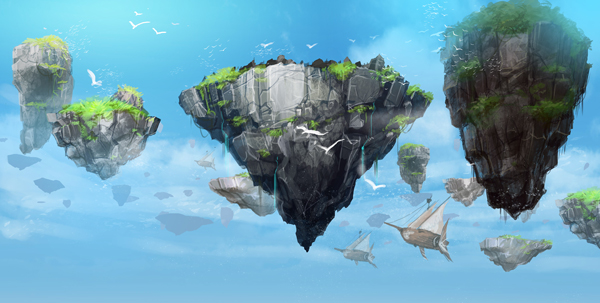Epilogue: High Council

From a historical standpoint, the years directly after the death of Ouranos are some of the most important since the Laxavis Wars. Despite the restabilization of the planes and the return of magic associated with the birth of the new World Dragon, many of the islands remained in a period of chaos and rebuilding for quite a time. The physical landscape of Ritenus had changed somewhat – most notably with the fall of several flying islands and the warping of the immediate area around the former Library of Jakardia – and various cities had been torn apart by wars and floods of interplanar refugees. In addition, the death of the gods Yl and Shooga disrupted several large religions and threw centuries of established theology into question. Perhaps the most far-reaching consequences of the event, however, were the fundamental power shifts that it prompted in society.
As described in Chapter 4, the world was then largely governed by a body known as the High Council, which was composed of a representative from each genera who had joined the union after the Laxavis Wars. This excluded kobolds, firbolgs, and yuan-ti. The tritons, split as they were into several nation states, did not send a single representative; instead, each coalition of tritons dealt with the High Council as a foreign body, and individually sent ambassadors to act in an advisory capacity. Ostensibly, the High Council had authority over the rest of the world; each participating civilization was bound to follow all Council laws and edicts. However, the High Council functioned less as a centralized, ruling body than as a loose coalition of independent states. Indeed, despite the strict laws against inter-genera wars, conflict always brewed just beneath the surface.
Before the death of Ouranos, the Dragonborn Empire was one of the most dominant political powers in the world. Their trade revenue was rivalled only by the tritons, who controlled sea trade, and the aaracokra, who continued to enforce their monopoly on air travel; their raw military power was unmatched, largely through the extensive use of trained paladins; through careful sponsorship of goblin artificers, many of the most impactful technological advancements originated on Praxlarr; and cities such as New Keteratonik were the largest and most diverse urban centers in the world. These factors combined gave the dragonborn representative significant authority in Council matters; most historians agree that it was the fracturing of the Dragonborn Empire that ultimately sealed the fate of the High Council.
It was the work of adventurers, initially, that sparked the investigations into the Council Representatives. When the actions of those heroes revealed the magnitude of the secrets that the Dragonborn Empire had been keeping, it shattered the illusion that the populace had previously maintained: that the Council could be trusted implicitly. It soon became evident that none of the High Council members were as blameless as they’d wish to appear. Tibian Tidebreaker, centaur representative, was caught selling classified information to none other than Airru, a member of the very Six that had killed Ouranos. Salan Terriex, it was revealed, had for years been using his position of power to protect a ring of smugglers and pirates. Sreelasa Calentia had been funding groups of airship manufacturers, despite explicit laws against the development of artificial flight. The various islands were soon at one another’s throats.
Meanwhile, individual societies were collapsing. The dragonborn religion splintered into warring factions; some claimed that the death of Ouranos was the final failure of the church and the ultimate condemnation of the religion, while others embraced the worship of [new World Dragon name] as the new dragonborn god. A small minority even formed cults venerating Raxtusar and the Six. As the church fell apart, so did the nation. Leadership of the Empire was disputed, and civil war seemed inevitable. Elsewhere, the death of both Shooga and Representative Foojya left the Loxodons completely without leadership. Into this power vacuum stepped Raxtusar, the White Dragon, who set about establishing herself as the god emperor of a newly formed kingdom, a union between the Loxodons and the previously unrepresented Kobolds. The relationship between Raxtusar and the Council was strained at best, and there seemed no clear way to enforce laws when faced by such a formidable foe.
It was in the midst of these disasters that the question of fault, unfortunately, was first raised. An anonymous essay was published by the Library of Jakardia that laid the blame for the entire disaster at the feet of the Dragonborn Empire. If the dragonborn had not maintained their obstinate secrecy for so long, the piece argued, the crisis may have been averted entirely. Indeed, for such a supposedly powerful nation, they proved remarkably ineffective at defending the World Egg; it was stolen from right underneath their noses, and only the timely intervention of hired adventurers prevented it from being consumed altogether. It was as inflammatory as the author had no doubt intended. What little order had remained on the Council dissolved into shouted arguments, finger pointing, and fruitless demands. Litor Vadu, Tortle Representative, resigned shortly thereafter, and Tibian Tidebreaker was convicted of treason and imprisoned. Saphara Clethtinthiallor mysteriously vanished (with foul play suspected but never proven), and Salan Terriex fled the island, carrying with him a number of stolen goods. On April 8th of ALX 219, with only four of the original ten members of the Council present, Sanctus Ignitori declared the official dissolution of the High Council.
Interestingly, the Library of Jakardia managed to emerge from this conflict without experiencing any significant reduction in power. Arguably, the library could be considered even more culpable for the disaster than the Dragonborn Empire; after all, the library’s leadership had been infiltrated by none other than a member of the Six, who nearly succeeded in stealing and consuming the World Egg. However, through careful essays and public statements, the new leaders of the library managed to almost completely shift blame onto the dragonborn, whose own issues prevented them from properly defending themselves. This was partially accomplished due to the generally favorable public opinion that the library had gained; while the extreme secrecy of the Dragonborn Empire had gained general mistrust over the years, the Library of Jakardia had established branches and offshoots on nearly every island, ingratiating themselves with the local population. Indeed, the new leadership of the library leaned into this aspect in the following years, building schools and establishing literacy programs all across Ritenus.
The dragonborn, however, refused much of the library’s aid due to their formal betrayal, and as a result the rebuilding process on Praxlarr remained a disorganized, largely ineffective affair. The lack of a single central authority left local leaders to govern individually, and skirmishes between opposing religious splinter groups only added more problems. Though thoroughly embroiled in this chaos, however, goblin society remained remarkably unscathed. Despite the death of Yl and the splintering of the Dragonborn Empire, goblin merchants, craftsmen and artificers continued their work in the same haphazard manner they always had. In fact, organizations such as the Artificer’s Guild provided much needed stability for the people of Praxlarr. As the factions among the dragonborn priesthood split into opposing nations, the goblins largely remained impartial, focusing on the physical aspects of rebuilding and recovery. Without the restrictions that the High Council had placed on industrialization, aspiring inventors had nothing but feasibility to prevent their ideas from becoming reality. Indeed, the instrumental role that various pieces of artificery had taken on during the Battle of Jakardia had shifted public opinion. The world was ripe for a technological revolution.
It was a few years after the fall of the Council that a new proclamation was published, jointly, by the science guilds of the kenkus and the tinker’s guilds of the goblins. Written by none other than Drizzik Rezzenson and Sreelasa Calentia, it announced the formation of the Craftsmen’s Federation, a union of the mercantile guilds of each culture. The proclamation announced a commitment to the free exchange of information and ideas, as well as standardized guidelines for trade and manufacturing. Though the stated purpose and function of the Federation were very different, many saw it as a successor to the High Council. The next few decades saw it rise steadily in membership and influence.
The death of Ouranos and the subsequent collapse of many old governments seemed to indicate the beginning of a new era. Ritenus was becoming a different world; a world where the old magical methods were rejected in favor of technological innovation; a world where the lines between island nations were increasingly blurred; a world where power was no longer solely in the hands of governments, but also held by trade organizations such as the Craftsmen’s Federation, or even the growing underground X-Society; a world no longer beholden to the traditions of the past. It is fitting, then, that historians have termed this period of time “the Rebirth”.
– Excerpt from A Student’s History of Ritenus, published 302 ALX


